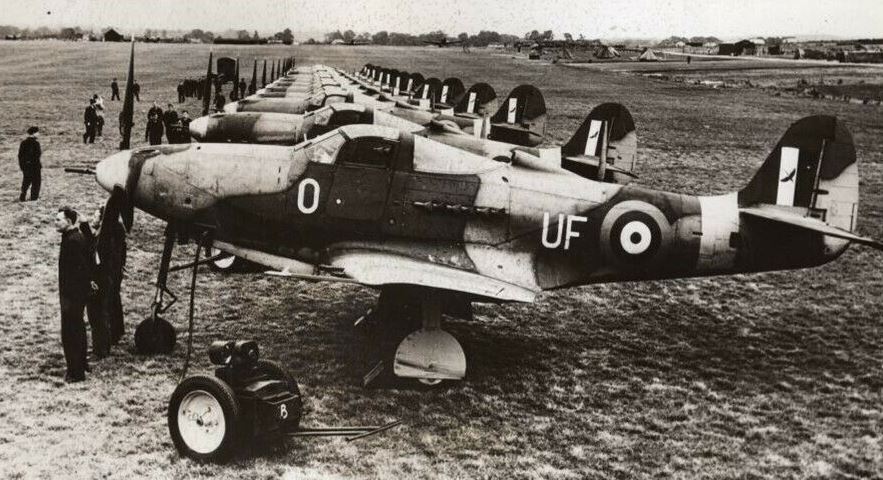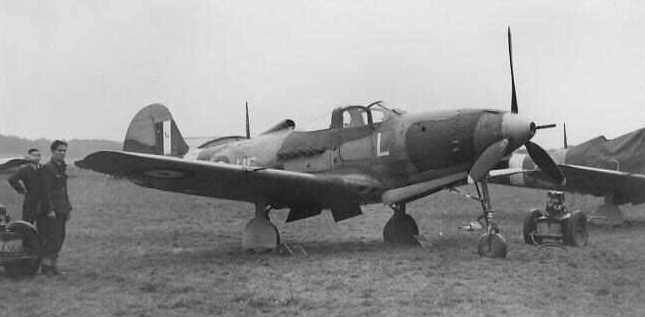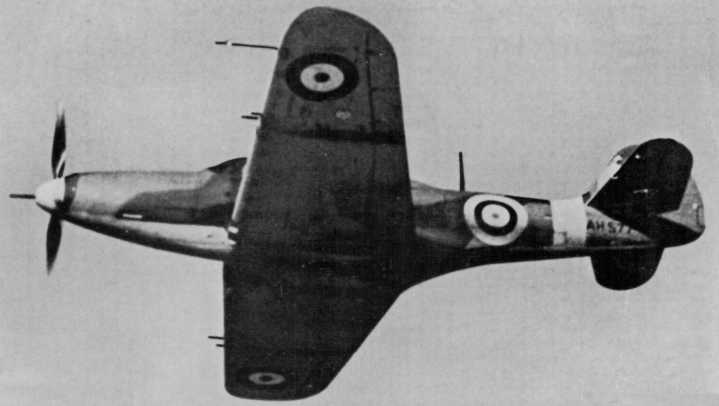Dinger's Aviation Pages
Some thoughts on the rejection of the P39 / P400 Airacobra by the RAF.
The P39 Airacobra is one of those aircraft that is a constant source of discussion, sometimes heated argument, between aviation enthusiasts. How could an aircraft that was particularly liked by the Soviets, be regarded as a failure by the Americans, and be rejected completely by the British RAF after only a few combat sorties? I don't pretend to know the complete answer; I would just highlight some points that are rarely brought up in modern discussions of the type, being largely forgotten.

Lined up for inspection by the press, Airacobras of 601 Squadron at Duxford in August 1941.
On the 1st March 1940, an article appeared in the British weekly Aeroplane magazine. It was highly critical of the new Bell P-39 Airacobra and the performance claims made for it. One point the author stressed was that a mid-engined aircraft requires a long extension shaft to the prop. That adds extra weight to the aircraft, weight that is avoided in a traditional front-engined design. So, all things being equal, a properly designed front-engined fighter would always be superior to a mid-engined one because it would not carry the additional weight of the extension shaft. The added weight and complication of the big steerable nose-wheel would only compound the matter. The author also had a particular issue with the location of the carburettor air intake behind the cockpit, which he asserted would be highly inefficient. The position of the engine behind the pilot was also criticised as in a crash it could "run over” the pilot (this was a particularly British concern reflecting the experience with pusher aircraft such as the Fe2b and Vickers Gunbus in the First World War). The tone of the whole article was nasty and sarcastic, and it ended on a particularly sour note.
“As a serious fighter the Bell is all wrong. We trust the British Purchasing Commission in the USA will not be hoodwinked into placing an order”
The article was anonymous, but no one had any doubts who had written it – the dreaded Charles G Grey, editor of Jane's All the World's Aircraft and founder of the Aeroplane magazine.
It is hard now to realise just what influence the old fool had in Britain at the time. He was the man who had led the campaign to close down the Royal Aircraft Factory during World War One, just as it was about to deliver some very advanced designs and an outstanding engine.¹ The Air Ministry ran scared of him on many issues. His fascist sympathies and pro-German attitude eventually proved too much for the publishers of "The Aeroplane" and he was sacked when war broke out in September 1939. However, he was snapped up as an air correspondent by various newspapers and continued to produce books and magazine articles, including this one about the Airacobra. Grey had some peculiar prejudices and theories about aircraft design, many of which were proved wrong. However, in denigrating the P-39, he did have a valid point, however nastily and disparagingly he made it. The performance figures published by Bell were misleading, having been obtained with a highly polished prototype with all armament, armour and radios removed.
So you can imagine the trepidation of the Air Ministry and RAF when only a month later, the British Purchasing Committee selected the P-39 for production for the RAF in its modified P-400 "Caribou"² form with a 20 mm cannon instead of a 37 mm cannon and would also go on to take over the outstanding 9 million dollar French order for the type after the fall of France. It would only need a letter from some pilot to his MP or to a newspaper complaining of even the slightest problem with the new aircraft to have CG Grey down on them complaining of incompetence in the Air Ministry. When the new aircraft were tested after arrival in the UK³ and found to have a performance well below that expected, just as CG Grey had prophesied 18 months earlier, you can imagine alarm bells started ringing in the Air Ministry!

The first RAF Airacobra combat mission was on the 9th October 1941, when two took off from Manston and flew to the French coast. They strafed a trawler and German troops on a pier.
The other problem with the P-400 was the timing of its arrival in the UK. In early 1941, there was every expectation that the Luftwaffe would soon renew daylight attacks on Britain. When the Battle of Britain had petered out in 1940, combats had been happening at increasing heights, with the Germans taking advantage of the better high-altitude performance of the newly introduced E-4/N and E-7 versions of the Bf109 fighter with their DB601N engines. The RAF expected that when the battle was re-joined, it would start where it had left off, with combat at increasing altitude and maybe with the Germans using new high-altitude pressurised bombers. This had led to the emergency development of the mark VII and VIII high-altitude versions of the Spitfire and the fitting of the Merlin XX in the Hurricane mark II to give a better high-altitude performance. Again, you can imagine the dismay when the new P-400 arrives on the scene and proves to have a particularly disappointing performance at altitude. Even when the Germans invaded Russia, everyone assumed that the Soviets would be defeated in a matter of weeks and that the Germans would resume their attack on the UK in the autumn of 1941 or spring of 1942.
Another issue that came to light during testing was the time it took to turn around the aircraft. During the Battle of Britain, when a Hurricane or Spitfire squadron returned to base after combat, they would usually come back in dribs and drabs, a few aircraft at a time. The armourers would work on the machine guns in the wings, and even though they had 8 machine guns, the way they were installed made them easy to reload without getting in anyone’s way. While this was going on, the fuel could be refilled and the oil and coolant topped up. So the turnaround time was remarkably quick, and the aircraft was ready for the next scramble in a very short time. Largely because of its mid-engine layout, the P-39/ P-400 took much longer to turn around. With the armament in the nose and awkward to get at, the armourers were in the way of the fuel replenishers. Some of the maintenance procedures it was possible to do with the guns remaining in situ on Spitfires and Hurricanes were found impossible to do on Airacobras unless the guns were removed from the aircraft entirely. In the case of the nose-mounted 20mm cannon, that meant involving airframe and instrument fitters to extricate the cannon and refit it. Time to turn-around is a powerful force multiplier and remained a central feature of RAF thinking into the cold war (the quickly switchable cannon packs on the Hunter jets being a case in point).

In all, 601 Squadron flew just eight combat sorties in the Airacobra. Early in 1942, they were re-equipped with Spitfires.
The RAF defence structure, based on sector stations each controlling a limited number of squadrons, had been a great success in 1940 but it was also inflexible. All day-fighter squadrons had to be capable of being sent against any incoming force and at whatever height, be they bombers or an enemy fighter sweep (one of the reasons for the withdrawal of the Defiant from the Day-fighter role in 1940). It simply would not have been possible to have some P-39 /P-400 squadrons limited to only low-altitude interceptions, and also taking twice the time to turn around.
So you see, the P-39 was just not suitable for the battle RAF Fighter Command thought it was going to have to fight in 1941 or 1942 once the Germans were through with defeating the Russians. Of course, neither the altitude nor the turnaround time matters when you go into offensive operations or if you provide air defence over your front line by flying standing patrols. Then, as the Russians did, you can dictate what altitude you want to fight at and take your time re-arming and refuelling your aircraft, ready for the next mission.
So when you add this evaluation to the possibilities of the “CG Grey” issue, you can perhaps appreciate why the Air Marshals jumped at the chance to unload the P-400s onto the Soviets!

Listing of the Bell "Caribou" in a British magazine from January 1941. It claimed an astonishing top speed of 400 mph and a range of 965 miles at a cruising speed of 335 mph while carrying an armament of one 37mm cannon and eight machine guns. When delivered, the RAF's "Caribous" had a 20mm cannon instead of the 37mm and only 6 machine guns (albeit two of them were the more powerful .50 calibre Brownings). Top speed was only 355 mph at 13,000 feet with a range of only 300 miles unless a drop-tank was carried.
NOTES
¹ The RAF8 engine, later developed as the Armstrong Siddeley Jaguar.
² When the P-39/P-400 was first ordered for the RAF, it was given the name "Caribou" and the first press releases and aircraft recognition diagrams issued for the type referred to it as such (although an alternative spelling of "Cariboo" was also sometimes used, which refers to an area of Canada rather than the animal). By the time it was actually used by the RAF, it had reverted to its American name of Airacobra.
³ No British pilot flew an Airacobra for evaluation in the USA until the end of December 1940, some 8 months after the British Purchasing Commission had ordered the type. The first Airacobras arrived in the UK in early July 1941, but these were a small batch of three P-39C Airacobras supplied under lend-lease directly from USAAF stocks and meant only for trials and evaluation. These three aircraft had the American 37mm cannon rather than the British 20mm cannon. Export of the 37mm cannon had been prohibited at the time the P-400s were ordered, and the British wanted commonality of ammunition with their other fighter aircraft anyway, but the start of lend-lease meant 37mm cannon could be "lent" to the British. The first P-400s purchased by the British arrived at the end of July 1941 (the lend-lease act was not retrospective; the British had to pay for all equipment ordered before the act came into effect or specifically built or modified to British requirements). The P-400s began to arrive at No 601 Squadron in August 1941.
PDF copy of the Aeroplane Magazine article of 1st March 1940.
Sources and suggested further reading on the Airacobra.
Airacobra I for the RAF, P-400: An excellent page on Joe Baugher's website <Link here>
Airacobra: Hero of the Soviet Union: An article by Dan Zamansky in issue 30 (January 2020) of The Aviation Historian magazine.
Flying Cannon - Bell's Cobra Family, Part 1: An article by Ken Wixey in Air Enthusiast Magazine, Issue 81, May/June 1999.
RAF Airacobras: An article in the third (Autumn) 1996 edition of Air-Britain Aeromilitaria magazine. It gives details of the initial RAF evaluation of the Airacobra when they first arrived in the UK.
Bell P-39 Airacobra: A book by Robert F. Dorr and Jerry C. Scutts published by The Crowood Press in 2000. ISBN 1 86126 348 1. While this is an excellent book on the American use of the P-39, it does have a series of errors (on page 34 in my edition) in dating the RAF's use of Airacobras to 1942! A full year later than when they actually operated.
Anything To Anywhere: An article In the March 1995 edition of Aeroplane Monthly magazine by Ann Welch, wartime ATA pilot. It covers just one month in her logbook during which, amongst a multitude of other types, she ferried eleven Airacobras. It certainly conveys the suspicion and trepidation felt by British pilots flying the aircraft for the first time.
Zero to Hero: An article in the digital Issue 3 of Wingleader Magazine. It gives details of the few combat sorties flown by RAF Airacobras.
P-39 Airacobra in Action: by Ernie McDowell with illustrations by Don Greer, Number 43 in the Squadron/Signal Aircraft Series. Published in 1980.
Sources and suggested further reading on the Airacobra.
Airacobra I for the RAF, P-400: An excellent page on Joe Baugher's website <Link here>
Airacobra: Hero of the Soviet Union: An article by Dan Zamansky in issue 30 (January 2020) of The Aviation Historian magazine.
Flying Cannon - Bell's Cobra Family, Part 1: An article by Ken Wixey in Air Enthusiast Magazine, Issue 81, May/June 1999.
RAF Airacobras: An article in the third (Autumn) 1996 edition of Air-Britain Aeromilitaria magazine. It gives details of the initial RAF evaluation of the Airacobra when they first arrived in the UK.
Bell P-39 Airacobra: A book by Robert F. Dorr and Jerry C. Scutts published by The Crowood Press in 2000. ISBN 1 86126 348 1. While this is an excellent book on the American use of the P-39, it does have a series of errors (on page 34 in my edition) in dating the RAF's use of Airacobras to 1942! A full year later than when they actually operated.
Anything To Anywhere: An article In the March 1995 edition of Aeroplane Monthly magazine by Ann Welch, wartime ATA pilot. It covers just one month in her logbook during which, amongst a multitude of other types, she ferried eleven Airacobras. It certainly conveys the suspicion and trepidation felt by British pilots flying the aircraft for the first time.
Zero to Hero: An article in the digital Issue 3 of Wingleader Magazine. It gives details of the few combat sorties flown by RAF Airacobras.
P-39 Airacobra in Action: by Ernie McDowell with illustrations by Don Greer, Number 43 in the Squadron/Signal Aircraft Series. Published in 1980.
